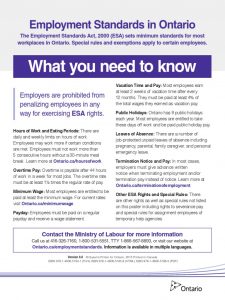Is Your Employer Required to Give You Permanent Restriction After a Request For Unemployment Compensation?
Permanent Restriction After a Request For Unemployment Compensation
You have just read an advertisement about an employment sacking and the phrase ” Employment Standards Termination Pay” appears in bold, capital letters. Your mind whirled, did you just read that right? Did you actually read that? Then again, perhaps your article was not very well worded, or maybe you are just as anxious to find out more about this advertisement and it drove you away from the keyboard, or maybe, just maybe, you just had a bit of extra time on your hands.
While, at first glance, there does not seem to be anything out of the ordinary about this advertisement, it may not be so. There is nothing wrong with an advertisement that says, “Work at Home Scam,” or, “Don’t Be A Victim of a Work At Home Layoff!” In fact, these are two very legitimate advertisements. They pertain to very real situations and concerns and employers have a right and a responsibility to address them. An employment standards termination pay in this case could be interpreted as an employee’s last resort and is something that would be taken very seriously by most employers.
But, what do I mean by an employment standards termination pay? If a company’s insolvency turns out to be a good case against labour ministry severance pay, then they may pay the employee for the period of time up to eight weeks, and possibly even more. The number of weeks is specified in the advertisement and is usually followed by a line next to it indicating the amount in thousand dollars. This type of advertisement has nothing to do with the employee being let go; it is a regular company policy for employees to receive a portion of their redundancy pay in lieu of suffering a dismissal.

Is Your Employer Required to Give You Permanent Restriction After a Request For Unemployment Compensation?
The adverts about a company’s insolvency often include information on what will happen if an employee quits without notice. The adverts will explain that a layoff is a serious situation where an employee quits without notice or just after notice. In many cases, the adverts may indicate that a dismissal due to a layoff is considered to be a constructive dismissal. Constructive dismissals occur when an employer has not complied with the basic employment procedures required by the government. Constructive dismissals are very common as laidoff employees often feel bitterness towards their former employer, who they think, has treated them unfairly.
So, you might think that this advertisement has not loaded yet, but this advertisement has not loaded yet! If you read my article content below, you will understand why: First of all, I am telling you that an employment standards ad does not necessarily mean that an ad complies with the federal government’s laws on this matter, so you should read my article content from the very start to learn this. Secondly, I am suggesting that you hire a good lawyer to find out what will happen in case an ad is deemed to be inconsistent with employment law. If you do not have an attorney yet, you should contact me so we can discuss this further. Furthermore, this article content indicates that many adverts have been found to contain improper clauses that could be considered to be discriminatory. As such, if you are reading this article, it is my strong recommendation that you hire a good employment lawyer to find out what will happen if an ad is found to be inconsistent with employment law.
You should note that my suggested solution to this problem has been controversial in some corners of the internet. However, I believe that a temporary layoff is appropriate for certain circumstances. An example is that an employee undergoes a short term layoff to allow him to obtain certain training opportunities. A temporary layoff can also be applied when an employee has excessive medical expenses that must be taken care of promptly. It is important for me to stress that a temporary layoff should only be used as a last resort for an employee who is ill-equipped to return to work.